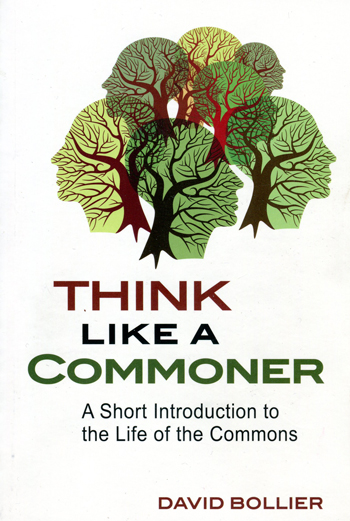B O O K R E V I E W
The Common Sense of the Commons

Think Like A Commoner
A Short Introduction to the Life of the Commons
David Bollier
New Society Publishers
196 pages $16.95
The Boston Common was not set aside so there would be a place for firework displays on New Year’s Eve, but so that residents of the town had a place to graze a cow or horse, or to sit on the grass in the shade of a tree. Colonial American towns were laid out with a town common in the same spirit of mutual aid. There are abundant examples from around the world of this ancient common sense recognition of common need and the mutual benefits of responding positively.
Think Like A Commoner – A short Introduction to the Life of the Commons is an introduction. But it is an introduction to a wide range of topics and historical facts about the commons and the people who have used, maintained and respected them for centuries. Bollier covers the basics in some commons and the evolution of new commons like the internet. More important are the references to the work of those who have spent their professional lives studying, writing about and protecting various commons. The work of Nobel prize winner Elinor Ostrom, who early on discredited Garrett Hamlin’s claim in 1968 that humans will inevitably overuse common resources. Ostrom likely contributed to Hamlin later admitting he was wrong. Vandana Shiva, Lawrence Lessig and Raj Patel are a few others writing about the commons. His long list of references to further reading and websites on the commons is equally valuable.
Ancient examples go back before the Magna Carta, but it is one example of an official recognition of commoners rights. Bollier writes about one of the most known loss of commons, the English Enclosure Acts, which threw thousands of English farmers off the land and handed it over to the emerging industrial woolen industry of the 18th century.
Bollier writes of a contemporary enclosure movement. “One of the most audacious new enclosures of nature involves the financialization of natural resources. Rather than treat land, water and local ecosystems as resources that should abide by the imperatives of nature, hedge funds and other investors are starting to develop clever financial instrument to ‘securitize’ the revenues that can be generated by renewable natural systems, such as flows of water, harvestable timber and fish stocks.”
This is the undercurrent in the move to the groundfish catch shares system.
Not long ago, American cities and towns had public water fountains for the obvious need of their citizens. There were also public restrooms in recognition of common needs and mutual aid. Small towns had a common water supply in the center of town and, in some cases, a hand-operated well pump, providing water to have a drink, carry home, relieve a parched dog, horse or car radiator. Why did these things disappear and what has replaced them?
Think Like A Commoner goes a long way in answering this and illuminating both the importance of retaining the basic human rights under the commons umbrella and how that might be done.
